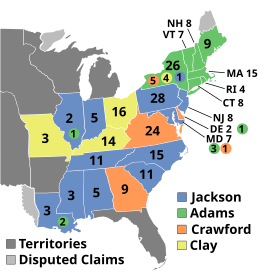Presidential election in the United States 1824
| ‹ 1820 • |
|||||||||||
| 10. Presidential election | |||||||||||
| October 26 - December 2, 1824 | |||||||||||
|
|
|||||||||||
| Dem.-Rep. Political party | |||||||||||
| John Quincy Adams / John C. Calhoun | |||||||||||
| electors | 84 | ||||||||||
| be right | 113.122 | ||||||||||
|
|
30.9% | ||||||||||
| Dem.-Rep. Political party | |||||||||||
| Andrew Jackson / John C. Calhoun | |||||||||||
| electors | 99 | ||||||||||
| be right | 151.271 | ||||||||||
|
|
41.3% | ||||||||||
| Dem.-Rep. Political party | |||||||||||
| William H. Crawford / Nathaniel Macon | |||||||||||
| electors | 41 | ||||||||||
| be right | 40,856 | ||||||||||
|
|
11.2% | ||||||||||
| Dem.-Rep. Political party | |||||||||||
| Henry Clay / Nathan Sanford | |||||||||||
| electors | 37 | ||||||||||
| be right | 47,531 | ||||||||||
|
|
13% | ||||||||||
|
|
|||||||||||
| Election results by state | |||||||||||

|
|||||||||||
|
7 states of
Adams / Calhoun |
12 states
Jackson / Calhoun |
||||||||||
|
2 states
Crawford / Macon |
3 states
Clay / Sanford |
||||||||||
|
|
|||||||||||
| President of the United States | |||||||||||
The 1824 presidential election in the United States took place from October 26 to December 2, 1824 and is widely viewed as a reorientation. In the previous years, the United States had been led by a one-party government, as the federalists had disbanded, leaving only the Democratic Republican Party . In that election, that party split up when four of its candidates ran for the presidency.
The part of the party led by Andrew Jackson later developed into today's Democratic Party , the circles around John Quincy Adams and Henry Clay later became the National Republican Party , from which the United States Whig Party emerged in the mid-1830s .
This election is remarkable in that it was the only one that has been decided in the House of Representatives since the introduction of the 12th Amendment to the Constitution , as none of the candidates on the electoral body could win a majority. This election is often said to have been the first in which a president would not have won the Popular Vote . This is difficult to determine, since a quarter of the states did not hold any elections in the strict sense, but instead their parliaments chose the electors.
Candidates
The following applied for the presidency:
- General Andrew Jackson of Tennessee , a charismatic hero of the 1812 War and a former MP and Senator;
- John Quincy Adams of Massachusetts , son of former President John Adams ;
- William H. Crawford of Georgia , former US Ambassador to France, former Senator from Georgia and former US Secretary of War and then Treasury Secretary, and
- Henry Clay of Kentucky , known as the "Great Compromise Finder," who was then the Speaker of the House of Representatives.
Result
None of the presidential candidates could win an absolute majority in the electoral body, so the House of Representatives had to decide on the presidency. Meanwhile , John Caldwell Calhoun won the election of Vice President without further ado with a result of 182 electoral votes.
| candidate | Political party | be right | electors | |
|---|---|---|---|---|
| number | percent | |||
| Andrew Jackson | Democratic Republican Party | 151.271 | 41.3% | 99 |
| John Quincy Adams | Democratic Republican Party | 113.122 | 30.9% | 84 |
| William H. Crawford | Democratic Republican Party | 40,856 | 11.2% | 41 |
| Henry Clay | Democratic Republican Party | 47,531 | 13.0% | 37 |
| Massachusetts Votes | - | 6616 | 1.8% | 0 |
| Other | - | 6437 | 1.8% | 0 |
| total | 365.833 | 100% | 261 | |
The required number of votes in the electoral body would have been 131 ; none of the candidates achieved this majority.
The election in the House of Representatives
The 12th amendment meant that only the three candidates who had received the most votes on the electoral body were allowed to stand for election. So Henry Clay was eliminated and the presidency chose between Andrew Jackson, John Q. Adams and William Crawford. Clay, who hated Jackson, supported Adams in the House of Representatives election (whose spokesman he was at the time) - also because his ideas largely coincided with those of Adams.
In the election on February 9, 1825, John Q. Adams received 87 votes in the first ballot, Jackson 71 and Crawford 54. The decisive factor for victory in an election in the House of Representatives, however, are the states, here the result was 13 to 11 - of which 7 for Jackson and 4 for Crawford - an absolute majority for Adams.
Adams' victory shocked Jackson, who, having received both the most electoral and electoral votes, he believed should have been elected president. When President Adams named Clay his secretary of state, effectively his designated successor - Adams and his three predecessors had each been secretary of state - Jackson accused Adams and Clay of horse trading. Jackson's supporters carried this on their flags for the next four years, which ultimately led to Jackson's victory in 1828, when Jackson again faced Adams, but then won the election.
literature
- Donald Ratcliffe: The One-Party Presidential Contest: Adams, Jackson, and 1824's Five-Horse Race. University Press of Kansas, Lawrence 2015, ISBN 978-0-7006-2130-9 .
- Donald Richard Deskins, Hanes Walton, Sherman C. Puckett: Presidential Elections, 1789-2008: County, State, and National Mapping of Election Data. University of Michigan, Ann Arbor 2010, ISBN 978-0-472-11697-3 , pp. 80-87 (= Chapter 12: John Quincy Adam's Election. ).



